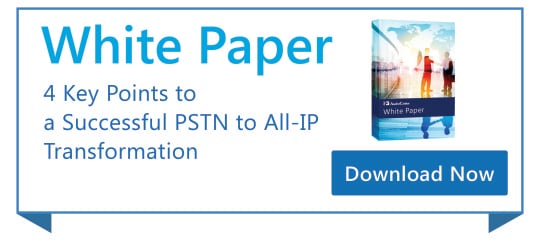We are living in exciting times as more and more fixed line operators have already begun to transition their PSTN networks to All-IP networks. AudioCodes' recently released whitepaper “4 Key Points to Successful PSTN to All-IP Transformation” covers some of the leading operators’ PSTN migration plans. Some of these operators, like Deutsche Telekom, have already taken significant steps into this plan. DT completed the PSTN migration in Macedonia, Slovakia and Croatia and committed to shutting down all of its European PSTN networks by the end of 2018.
Good analyst and media coverage on some of these All-IP transformation projects can be found in Iain Morris’ Light Reading blog posts such as “DT Completes All-IP Move in Croatia” and “Does BT Lag European Peers on All-IP?”, I also recommend an interview with Axel Clauberg, VP of Aggregation, Transport, IP & Fixed Access at DT in which he discusses DT’s ongoing migration to an All-IP network architecture (DT's Journey to a New IP World).
Though motivators such as the increasing maintenance costs of the PSTN switches, real-estate considerations and increasing competition from OTT players are making operators realize that they need to migrate their legacy networks to All-IP, the process is far from simple. In fact, it includes many elements such as migrating the core network to IP, replacing the customer’s on-premises equipment, introducing new services to end-customers and more.
At AudioCodes we defined 4 key points with a recommendation for the operators to follow as part of their PSTN migration plans.
1. The Time is Right for All-IP Transformation
Even though there are many drivers for PSTN migration, the process is complicated and will take a long time. For some operators, PSTN migration is still a low priority, while others are ahead of the curve, but on one thing there is market consensus: PSTN migration will be necessary and urgent within the coming years. Many TDM switches vendors already declared end of life and support, challenging the operators with increased maintenance costs and a lack of spare parts and expertise. Adding to the equation, operators that already have plans for completing PSTN migration by 2020, will cause vendor support to decrease significantly. Operators need to have a plan of action now or risk being stranded with an obsolete network
2. Focus on Business Customers
Although one of the main triggers for operators to transfer to All-IP network is the significant decrease in the number of PSTN residential lines, they need to keep in mind that once they start the transition process, it will cover 100% of their network, including business lines. It is critical for operators to focus on their business customers during the PSTN migration process for several reasons:
- In terms of revenue, business customers generate (globally) 44% of the total fixed voice lines revenue
- Business customers, when compared to residential ones, are more sensitive to changes in voice services as they are critical to their on-going business operations
- The potential future voice service revenue from business customers is much higher, compared to the residential market, when moving to All-IP services such as cloud UC services
3. Ensure a Successful PSTN Migration Process
A significant challenge to the transformation of PSTN to All-IP is the long process that operators will face, such as migrating on a massive scale on time and on budget and ensuring that the transformation has zero impact on existing services and end users. Focusing on these key pillars during the PSTN migration process will help operators to achieve optimal results:
- Cover any deployment scenario and migrate 100% of the network with solutions for any topology type (on-premises and CO), for any customer size from SOHO and up to large enterprise, and for customers using any existing service
- Avoid customer churn - make sure to have zero impact on end customers during the migration process and ensure high quality service after migration to the new IP network is complete
- Minimize migration costs using reliable and easy deployment devices and automated services that will reduce engineering and support costs
- Optimize migration time with quick installation and configuration of on-site devices by deploying solutions that offer wide-ranging interoperability, zero-touch provisioning and remote configuration tools
- Enable future cloud services using devices that are “cloud ready”. This will ensure operators can achieve a quick, easy and cost-effective move to cloud services once the PSTN to All-IP transformation is complete
4. Use Smart Cloud Transformation
Congratulations! You have successfully migrated your network and services to All-IP. Now it’s time to start and harness the power of the new all-IP network and to generate more revenues from services such as cloud UC. Well, not so fast. During the PSTN migration process the operator will need to disconnect business customers’ voice systems from the PSTN and reconnect them to the IP network using VoIP gateways. 77% of these business customers are still using on-premises PBX systems, and although they will now be connected to the all-IP network, migrating their telephony services to the cloud is not a straightforward matter.
A ‘smart cloud transformation’ approach will allow operators to address this challenge:
- Don’t try it all at once. A gradual migration that is based on hybrid and modular solutions will enable the operator, to connect their customers to IP services quickly and with minimum disruption, while also being able to migrate these customers to cloud services without needing to revisit the customer and reinstall equipment in the future. In addition, the on-premises PBX and the new hosted PBX can be merged into a single telephony solution
- Provide solutions that will enhance the advantages of the cloud and that will enable to allay customers’ fears of moving to the cloud. Such solutions should include features such as superb voice quality, backup options, ‘always on’ services, and holistic management and monitoring that will enable the operator to guaranteed enhanced QoS and QoE
Conclusion
There is no doubt that PSTN migration will become a critical issue over the coming years. Service providers need to have a plan in place now to avoid hurdles that will become more difficult to surmount by 2020.
More information can be found in the
AudioCodes white paper “4 Key Points to Successful PSTN to All-IP Transformation”.




